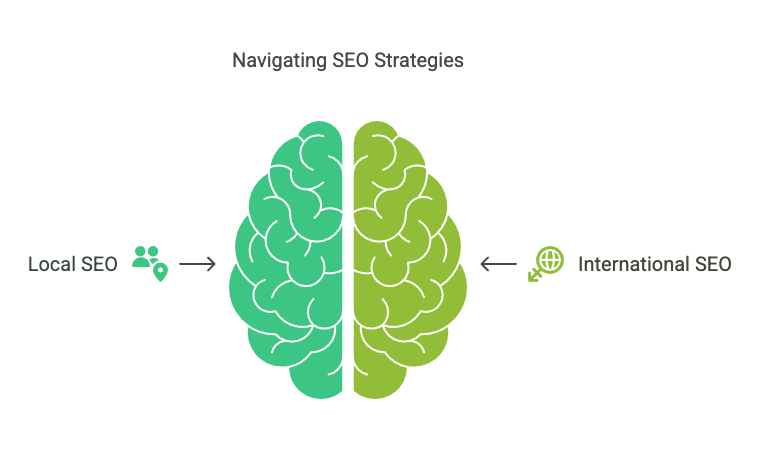Generally, search engine optimization is largely location-agnostic. It’s about creating compelling content, targeting the right keywords, and increasing the scope and reach of your brand through an understanding of Google’s algorithms. That said, location targeting can be an extremely powerful tool.
Where SEO is concerned, this generally takes two forms.
International SEO targets content outside your home country. It may also target languages other than your own. Big brands often use it. They want to expand globally. International SEO often targets multiple locations. This makes it a large project.
Local SEO, meanwhile, is much smaller-scale. It’s focused on placing within a particular city or community, often using location-specific keywords or leveraging Google’s location services. Generally geared more towards businesses with physical brick-and-mortar stores, local SEO also involves a Google My Business profile and customer reviews.
Where deciding which of these three tactics to use, it largely comes down to the market you’re attempting to reach.
A locally-owned restaurant, for instance, will want to employ local SEO. A large franchise with a presence in multiple countries, meanwhile, will need an international SEO approach, likely with multiple different teams. Some businesses may even blend the two, blurring the line between local and international as they do business on a global scale.

The Power of Local Search
We have explained that local SEO tries to build your brand’s reputation and name within a single community or city. Our goal is to provide exceptional service and make your business easy to find for local customers, who will leave positive reviews and tell friends, family, and colleagues about you. You may even end up becoming a staple of a particular community, known and beloved by all the locals.
The first and most important step in local SEO is the creation of your Google My Business profile. Not only does this provide another potential traffic route to your website, but it’s also a prime source of business information and reviews. Google has written fairly extensive guidelines on conduct, content, and eligibility for Google My Business; we’d strongly recommend familiarizing yourself with them.
Going Global With International SEO
Whether you’re looking to expand to a new market or noticing a lot of out-of-country traffic on your site, international SEO is geared towards capturing the attention of people outside your business’s current home country. While it has a bit in common with local SEO, it’s more focused on understanding your international audience, including the search engines they use and how they use them.
What aspects of their culture are unique? What will resonate with them? Is there any region-specific slang or shorthand of which you should be aware?
International SEO may also require the use of translation services if you’re trying to target an audience that doesn’t speak English. We would strongly recommend consulting with native speakers, hiring professional translators, or finding a marketing firm with staff who speak the language. Do not rely on a service like Google Translate, as software-based translators often result in inaccuracies.
Closing Thoughts
Location isn’t always relevant to your SEO efforts. But when it matters, it really matters. Understanding what’s involved in creating locally-targeted content is important, no matter the scale of your campaign. Regardless of your approach to SEO, it bears mentioning that mobile functionality is non-negotiable. Your website must be functional and streamlined on a wide range of smartphones and tablets. As we’ve said before, Google treats mobile-friendliness as a ranking factor, so there’s no excuse not to incorporate it.


